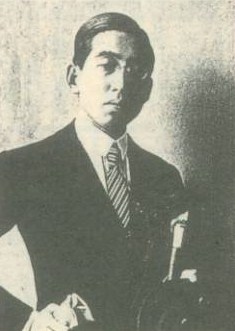Daigaku Horiguchi facts for kids
Quick facts for kids
Daigaku Horiguchi
|
|
|---|---|
 |
|
| Born | 8 January 1892 Tokyo, Japan |
| Died | 15 March 1981 (aged 89) Kamakura, Kanagawa, Japan |
| Occupation | writer |
| Genre | poetry |
Daigaku Horiguchi (堀口 大学, 8 January 1892 – 15 March 1981) was a famous poet and translator from Japan. He lived during the Taishō period and Shōwa period. He is known for introducing French surrealism to Japanese poetry. He also translated books and poems from over 66 French authors into Japanese.
Early Life and Travels
Horiguchi was born in Tokyo, Japan. His father was a diplomat who worked for the Japanese government.
Horiguchi went to Keio University to study literature. He did not graduate, which is interesting because his first name, "Daigaku," means "university" in Japanese! Even before college, he was writing tanka poetry. He was part of a group called Shinshisha (The New Poetry Society). Famous poets like Tekkan Yosano and Akiko Yosano encouraged him to write more.
In 1911, Horiguchi left school to travel with his father. For the next 14 years, he lived in many different countries. He learned to speak French very well, helped by his Belgian stepmother. He became very interested in French literature, especially the Symbolist movement.
He first spent over a year in Mexico. There, he found out he had tuberculosis. This meant he could not follow his father's wish for him to become a diplomat. Instead, he focused on writing poetry and translating French books. He was in Mexico during the Mexican Revolution. He also became interested in a poetry style called Parnassianism.
In 1913, his family moved to Belgium. He studied the works of poets like Paul Verlaine. He also lived in Spain, Paris, Brazil, and Romania for short times. While recovering in a hospital in Switzerland, he translated works by authors like Thomas Mann.
Becoming a Writer
In 1919, Horiguchi published his first poetry book, Gekko to Pierrot (Moonlight and Pierrot). He also released a book of waka poems called Pan no fue (Pan pipes).
When he returned to Japan in 1925, he published Gekka no ichigun. This collection of poems introduced Japanese readers to French writers like Jean Cocteau and Guillaume Apollinaire. This book had a big impact on modern Japanese poetry in the 1920s and 1930s. His translation of Paul Morand's Ouvert la nuit also influenced a group of Japanese writers called the Shinkankakuha.
In 1928, Horiguchi started his own poetry magazine, Pantheon. However, it stopped being published the next year. He then started a new poetry magazine called Orpheon.
Life During Wartime
In 1932, Horiguchi moved to a different part of Tokyo. In 1935, he became the vice-chairman of the Japan PEN Club. He even hosted Jean Cocteau when the French writer visited Japan.
Horiguchi did not agree with Japan's increasing focus on military power. After a new law was passed, he decided to stay at a hotel by Lake Nojiri. He continued translating French literature, even though the government was watching writers more closely. In 1941, he moved to Okitsu, Shizuoka. He briefly returned to Tokyo in 1942 for Akiko Yosano's funeral. He stayed in Shizuoka until 1945, then moved to Sekikawa, Niigata before the war ended.
Later Life and Achievements
After World War II, Horiguchi moved back to Shizuoka. In 1947, a collection of five volumes of his poetry was published. From 1950, he lived in Hayama, Kanagawa for the rest of his life.
In 1957, he became a member of the Japan Art Academy. He also met with André Chamson, the president of PEN International, who was visiting Japan. In 1959, one of his works won the famous Yomiuri Prize. For the next ten years, he was a popular speaker about modern Japanese poetry.
In 1967, he wrote a traditional Japanese poem about fish for the Utakai Hajime contest at the Imperial Palace. Emperor Hirohito, who liked marine biology, praised his poem. Horiguchi received the Order of the Sacred Treasures award.
In 1970, he became the honorary chairman of the Japan Poetry Club. In November of the same year, the Japanese government named him a Person of Cultural Merit. In 1973, he received another Order of the Sacred Treasures award. In 1976, a special collection of his poems, "Tôten no Niji" ("Rainbow in the Eastern Sky"), was published. It included beautiful illustrations by artist Hodaka Yoshida.
In 1979, the Japanese government gave him the Order of Culture, a very high honor. Daigaku Horiguchi passed away in March 1981 at the age of 89. He is buried in the Kamakura Reien cemetery.
During his life, Horiguchi published more than 20 books of poetry. His poems mixed the flexible Japanese style with the sounds of French. He was known for using everyday Japanese words in his translations. This helped his translated poems feel closer to the original French meaning.

